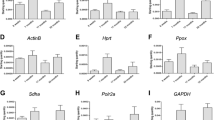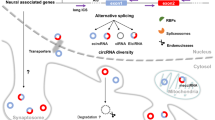Abstract
Transcription is the initial and generally the most sensitive step to cellular needs and environmental cues. Thus, it serves as a major mechanism controlling gene expression. Using reverse-transcription quantitative polymerase chain reaction technology (RT-qPCR), we will present how to quantify the transcriptional expression of NMDARs subunits during brain development and in both healthy and pathological conditions.
Access this chapter
Tax calculation will be finalised at checkout
Purchases are for personal use only
Similar content being viewed by others
References
Burnashev N, Szepetowski P (2015) NMDA receptor subunit mutations in neurodevelopmental disorders. Curr Opin Pharmacol 20:73–82. doi:10.1016/j.coph.2014.11.008
Paoletti P (2011) Molecular basis of NMDA receptor functional diversity. Eur J Neurosci 33(8):1351–1365. doi:10.1111/j.1460-9568.2011.07628.x
Paoletti P, Bellone C, Zhou Q (2013) NMDA receptor subunit diversity: impact on receptor properties, synaptic plasticity and disease. Nat Rev Neurosci 14(6):383–400. doi:10.1038/nrn3504
Traynelis SF, Wollmuth LP, McBain CJ, Menniti FS, Vance KM, Ogden KK, Hansen KB, Yuan H, Myers SJ, Dingledine R (2010) Glutamate receptor ion channels: structure, regulation, and function. Pharmacol Rev 62(3):405–496. doi:10.1124/pr.109.002451
Hollmann M, Heinemann S (1994) Cloned glutamate receptors. Annu Rev Neurosci 17:31–108. doi:10.1146/annurev.ne.17.030194.000335
McBain CJ, Mayer ML (1994) N-methyl-D-aspartic acid receptor structure and function. Physiol Rev 74(3):723–760
Moriyoshi K, Masu M, Ishii T, Shigemoto R, Mizuno N, Nakanishi S (1991) Molecular cloning and characterization of the rat NMDA receptor. Nature 354(6348):31–37. doi:10.1038/354031a0
Petralia RS, Yokotani N, Wenthold RJ (1994) Light and electron microscope distribution of the NMDA receptor subunit NMDAR1 in the rat nervous system using a selective anti-peptide antibody. J Neurosci 14(2):667–696
Anson LC, Chen PE, Wyllie DJ, Colquhoun D, Schoepfer R (1998) Identification of amino acid residues of the NR2A subunit that control glutamate potency in recombinant NR1/NR2A NMDA receptors. J Neurosci 18(2):581–589
Monyer H, Sprengel R, Schoepfer R, Herb A, Higuchi M, Lomeli H, Burnashev N, Sakmann B, Seeburg PH (1992) Heteromeric NMDA receptors: molecular and functional distinction of subtypes. Science 256(5060):1217–1221
Das S, Sasaki YF, Rothe T, Premkumar LS, Takasu M, Crandall JE, Dikkes P, Conner DA, Rayudu PV, Cheung W, Chen HS, Lipton SA, Nakanishi N (1998) Increased NMDA current and spine density in mice lacking the NMDA receptor subunit NR3A. Nature 393(6683):377–381. doi:10.1038/30748
Nishi M, Hinds H, Lu HP, Kawata M, Hayashi Y (2001) Motoneuron-specific expression of NR3B, a novel NMDA-type glutamate receptor subunit that works in a dominant-negative manner. J Neurosci 21(23):RC185
Pachernegg S, Strutz-Seebohm N, Hollmann M (2012) GluN3 subunit-containing NMDA receptors: not just one-trick ponies. Trends Neurosci 35(4):240–249. doi:10.1016/j.tins.2011.11.010
Lozovaya N, Gataullina S, Tsintsadze T, Tsintsadze V, Pallesi-Pocachard E, Minlebaev M, Goriounova NA, Buhler E, Watrin F, Shityakov S, Becker AJ, Bordey A, Milh M, Scavarda D, Bulteau C, Dorfmuller G, Delalande O, Represa A, Cardoso C, Dulac O, Ben-Ari Y, Burnashev N (2014) Selective suppression of excessive GluN2C expression rescues early epilepsy in a tuberous sclerosis murine model. Nat Commun 5:4563. doi:10.1038/ncomms5563
Acknowledgments
This work was supported by INSERM (Institut National de la Santé et de la Recherche Médicale) and by the European Union Seventh Framework Programme FP7/2007–2013 under the project DESIRE (grant agreement no. 602531).
Author information
Authors and Affiliations
Corresponding author
Editor information
Editors and Affiliations
Rights and permissions
Copyright information
© 2017 Springer Science+Business Media LLC
About this protocol
Cite this protocol
Pallesi-Pocachard, E. (2017). Quantification of NMDAR Subunit Genes Expression by qRT-PCR. In: Burnashev, N., Szepetowski, P. (eds) NMDA Receptors. Methods in Molecular Biology, vol 1677. Humana Press, New York, NY. https://doi.org/10.1007/978-1-4939-7321-7_2
Download citation
DOI: https://doi.org/10.1007/978-1-4939-7321-7_2
Published:
Publisher Name: Humana Press, New York, NY
Print ISBN: 978-1-4939-7320-0
Online ISBN: 978-1-4939-7321-7
eBook Packages: Springer Protocols




